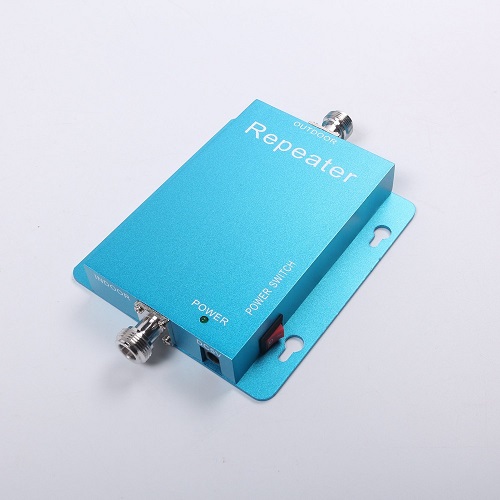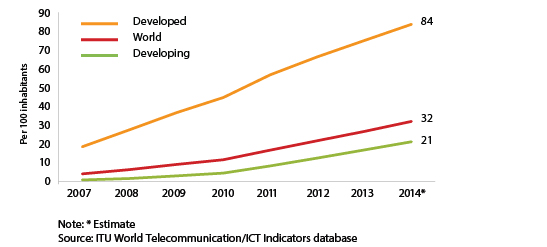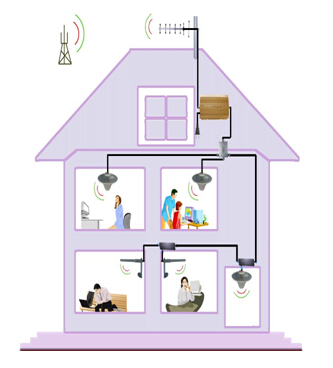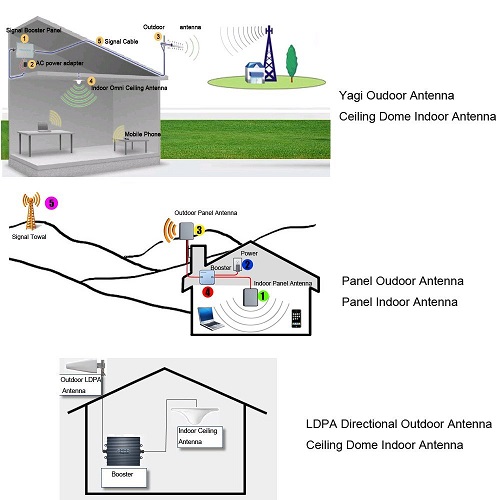Will I benefit from Having One?
The aim of this article is to explain what a cell signal booster is, how it works and how you might benefit by having one. But before we can look at that, it'll be helpful to understand a little of how a mobile phone network operates.-signal booster
First things first: a cell phone is not a telephone where calls are carried by wires and other media. A cell phone is a low-power two-way radio which transmits calls through the atmosphere. And like all two way radios, it can pick up broadcast signals and convert them to audio; or take in the analogue sounds of your voice, convert them into digital packets and transmit them into the radio network.-cell phone signal booster
The first mobile phones had to be installed in cars because they had a weighty but powerful electricity-hungry transmitter designed to reach a single antenna, perhaps as much as 50 miles away. This antenna received the calls and passed them into the telephone network, but only a few people could uses these radio telephones at a time because the antenna only had a small number of channels available.- phone booster
Cellular networks changed all this.

What is a Cellular Network?
Imagine you could see the cellular network in a city. What you'd see is a network of interlocking hexagons forming a network of radio coverage. Sometimes the hexagons overlap to create more capacity in areas where there is a high density or different types of user. Each hexagon contains a base-station comprising of an antenna, a supporting structure for the antenna, and power & radio equipment. Here's a visualization of Chicago by Nickolay Lamm.- cell phone booster
Lamm says: "Near the downtown area more users are likely to be found and hexagonal cells are smaller to serve approximately the same numbers of users found in larger cells elsewhere. Antenna signals extending beyond the original cells provide coverage orver part of Lake Michigan."- network booster
The basic idea of a cellular radio network is that instead of having one mega-antenna covering a area, lots of low-power antennas are used, each serving a small area. Switching software passes calls from one cell to another as the caller moves. Once a signal from a mobile phone hits the antenna of a base station, the equipment at the base station transfers the call to the main telephone network for onward transmission to the person receiving the call.Each cell can only support a fixed number of callers at any one time. So in areas of high demand there are more base stations. Also, newer cell phone technologies such as 3G, use small cells because of the larger quantity of data these base stations have to handle. 3G cells also expand and contract depending upon the throughput of data and that's why 3G cells often overlap more frequently than 2G cells.-mobile signal booster
Hang on a minute, you said 3G? 2G? And I've even heard of 4G! What's all that about?That's easy. G stands for Generation. Each new development in cell phone technology is called a generation, so 4G is the fourth generation.1G phones used analogue radio, arrived around 1981 and were replaced by 2G systems about 10 years later. The biggest difference between the two is that 2G was a digital system which allowed the encrypted transmission of data as well as voice signals. 2G was known as GSM (Global System for Mobile COmmunications) and because it was digital, we were introduced to the joys of text messaging - Short Message Services. (SMS).Yet another 10 years later, 3G arrived. 3G has several common names: EDGE, CDMA, UMTS and DECT. If you really want to know what these acronyms stand for, look them up using your favourite search engine. It doesn't really matter what the name is, the main thing you need to know is that 3G systems have higher data rates than the older digital platforms and they offer greater security. This meant that users could take advantage of not only text messaging services, but also mobile TV, GPS and mobile video to name but a few applications.-mobile phone signal booster
The platform for the smart phone had arrived and the world has since gone cell phone crazy, the number of mobile phone subscriptions now being equal to 95.5% of the world population, 84% of these being for mobile broadband.-3g signal booster
Global Mobile Broadcasting Subscriptions

And the march of technology continues.
In 2010 4G Mobile telecommunications arrived, right on time according to the 'new-one-every-10-years' rule; and pretty soon (2020?) well have 5G - an as yet undefined new standard for mobile telecommunications which is currently being researched by a number of groups, the first of which was at the University of Surrey in the UK.Unsurprisingly, 4G offers higher data rates and supports data and graphics hungry applications such as high definition TV, 3D TV and video conferencing. Not all world markets currently offer 4G services.-cell signal booster
WHAT IS A CELL SIGNAL BOOSTER?
You're driving along chatting to your friends on your cell phone, the younger kids in the back are happily occupied watching TV on a tablet, and the head-phoned teenager next to you is sealed in a private world, streaming music via their smart phone.You're in a city, so decent cellular coverage is expected - then ... you lose the signal. The magic of 4G has turned into the problem of No-G. The flaw in the vision of an always-on, fully-connected, mobile-enabled digital world has appeared: your phone can't see' the nearest cell tower and is unable to connect to the network.-antenna booster
1) It might be distance.
2) It might be because you're in an urban canyon, tunnel, or inside a building or vehicle mad of materials which deteriorate radio signals.
3) It might be that the nearest base-station is up to capacity serving other callers.
4) It might be that the georgraphy of the surrounding area is disadvantageous - trees, hills or mountains, for example.
Whatever the cause, what you need is a way of turning a weak signal into a stronger one so you can connect. What you need is a Cell Signal Booster.


A Cell Signal Booster is a piece of equipment which helps you to overcome weaknesses in the cellular network. If you're a long way from a tower and the connection is weak, it strengthens the signal. If the nearest tower in a city is fully occupied, it can connect you to another tower slightly further away.
In effect, a Cell Signal Booster is a mini version of an operator's base station. It receives a signal, amplifies it and then rebroadcasts it - either via an internal antenna or to the nearest cell tower via an external aerial. A the diagram above shows, typically, an external antenna picks up the signal from the nearest cell tower, this is then carried via coax cable to a cellular amplifier inside the building or vehicle where it's amplified and rebroadcast ready to be picked up by any cell phone nearby. Or vice versa - the whole system is a two-way operation.-network signal booster
Thinking about this, it's clear that the external antenna needs to have the best chance of 'seeing' the nearest tower. So if the Cell Signal Booster is a fixed location such as a building, then it's advantageous to place this antenna in a position where it can send/receive the best possible signal. Another thing to bear in mind is that if a received signal is weak, having a strong amplifier in the Cell Signal Booster means that the equipment can serve a larger area or greater number of users.-phone signal booster
TYPES OF CELL SIGNAL BOOSTERS
Cell Signal Boosters come in various guises depending upon your application, and prices vary accordingly.
Commercial systems designed to provide connectivity for many users, in a corporate office context for example, are designed to provide a much higher level of service that a Home or Small Office booster system which are largely intended to provide connectivity to a single or small group of users. And of course there are various types of Mobile booster systems for use in vehicles, mobile homes, RV's, boats and other similar context.It's also important to realize that the components from which the booster system is made can have a considerable effect upon its efficiency.-wireless signal booster
You could, for example, have the best amplifier in the world, but if the antennae are poor, or the connecting coaxial cable is not to a sufficiently high specification, the signal can never be improved by as much as it would be if these were better performing components. That's why there are price variations, particularly among the budget offerings on the market.-internet signal booster
Spending a little more to ensure that you have good quality components makes an enormous difference to the effectiveness of the booster when installed. And buying a kit from a reputable supplier which contains all the parts you need will help ensure that the components have been selected by the vendor to operate together effectively and give you the best outcome.Another thing to bear in mind when buying a Cell Signal Booster is that they operate at specific frequencies. Most booster today operate at multiple frequencies and so can work with a range of operators, but it's worth making sure that when you select a product, you talk t the supplier and explain your local setup, including the name of your telecoms provider.It's also worth making sure that you get good advice on the installation of the equipment. Boosters are not hard to install, and you can easily do it yourself. But it is worth making sure that you know what you're doing and follow the vendor's instructions precisely, otherwise you will not get the performance you paid for.-mobile network booster
COMMON MISUNDERSTANDINGS
Firstly, it's important to remember that a booster is just that: it can take a weak signal; amplify or boost it to make it stronger; and then rebroadcast it locally so that you can pick up the signal on your phone, aircard, or other cellular device.A Cell Signal Booster can't create a connection in either direction where no signal exists. Other technologies are available which can do this, but a Cell Signal Booster is not one of them. To help you decide whether a Cell Signal Booster is the right technology for you, talk to a reputable supplier.-cell phone antenna
Second, remember, you get what you pay for. If you buy a sticker for a few dollars that goes on the back of you phone and which claims to improve your connectivity, that's what you'll get - a cheap sticker. They don't work. Equally, buying an app for your phone won't do the job either.-cell phone antenna booster
If you think about it this makes sense. What we're talking about is a hardware issue - you phone is a radio with limitations, so running a piece of software on the phone can't overcome these physical limitations. The apps that you read about, simply drop your phone into aeroplane mode for a second or two so that your phone reconnects. The hope is that your phone will latch onto a nearer tower than the one it was talking to earlier and this will mean a stronger connection. To do this, you don't need an app. You can easily do this your self if you think it will help. But this approach is by no means a permanent solution or replacement for an effective Cell Signal Booster.-cell phone booster for home
Finally it's worth taking a look at this blog which explains the recent changes in the FCC regulations regarding the use and ownership of Cell Signal Boosters.-cell phone repeater
Some misunderstanding has arisen (or been promoted by unscrupulous vendors) that you have to change an existing previously purchased booster to comply with the new regulations. This is not true. As the blog explains, you don't have to renew or change your existing equipment, but any new equipment you buy must conform to the regulations which came in on May 1st, 2014.Reputable vendors will not sell equipment which doesn't conform to the new standard and you can check whether a new purchase does conform by looking for the appropriate FCC label on the equipment. This will confirm that the booster does indeed conform to these new regulations.-4g signal booster
AND THAT'S IT
We hope that this information document has answered many of your questions about Cell Signal Boosters.
We've taken a quick look at some common misunderstandings relating to Cell Signal Boosters. What we haven't done so far, is talk about whether you would benefit from owning this type of equipment.Of course the only person who can really answer the questions is yourself. If you've got cell phone connectivity problems, the obvious answer is to install a kit that boosts the radio signal from the cell towers and gives you more signal for your phone to grab on to. And as we've explained, that's exactly what a Cell Signal Booster does - it helps you to bypass any problems arising from your location, the materials surrounding you as you try to connect or other issues relating to you cell phone usage at home, at work, or at leisure.-cellular signal booster
Of course a Cell Signal Booster can't completely eliminate all problems, but it could go a long way to helping you overcome the worst of these by:
-
Reducing dropped calls
-
Improving 3G and 4G data rates
-
Keeping you connected further from the cell towers
-
Increasing your coverage area, especially in mobile situations such as in your vehicle, RV, or boat.

Which brings us to the final point.
Several times we've mentioned the phrase 'Reputable Supplier'. And although you might think we're bound to say this, it's important that you consider this when thinking about buying cellular telecommunications equipment.-signal amplifier
There are a lot of websites around from businesses whose sole expertise is to act as a middleman between the manufacturer of the equipment and yourself. Once they've got your money, that's it. But, as I hope you will have realised by reading this document, selecting, buying and installing a Cell Signal Booster requires good advice.-gsm signal booster
If you need mobile signal booster,do not hesitate to contact us.our professional technical team will supply you the good service.




